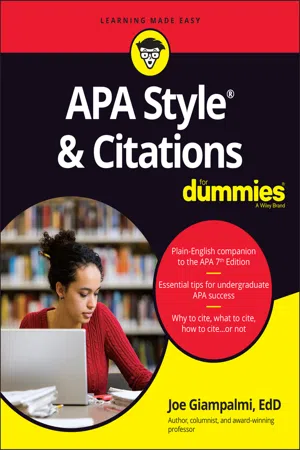
- English
- ePUB (mobile friendly)
- Available on iOS & Android
APA Style & Citations For Dummies
About this book
Write right in for scholarly success
While world-renowned for the precision and clarity it lends to scholarly writing, keeping track of APA style's exacting standards can be demanding (at times even excruciating!) for initiates and seasoned writers alike. Created and governed by the American Psychological Association, it provides a universal style for formatting, citations, and footnotes in psychological research, behavioral and social science journals, and beyond. Getting up to speed is tough stuff, but once you've got it, your work will have that easy-to-follow scholarly authority that will get high marks from your professors and peers alike.
Your friendly, frustration-free guide for this adventure in simplifying APA style is Joe Giampalmi, who has taught more than 100 APA-style composition courses to college students. He takes the pain of following APA style away by breaking it down to its essential elements and focusing on the important stuff students encounter most. You'll work through specific, real-life examples of using APA style for psychology, criminology, business, and nursing papers. In addition to demystifying the intricacies of formatting and citation, APA Style & Citations For Dummies has got you covered in all matters of grammar and punctuation—as well as guidance on how APA style can help you negotiate issues around the ethics of authorship and the importance of word choice in reducing bias.
- Develop conciseness and clarity
- Pay attention to flow, structure, and logic in your writing
- Know when, why, how, and what to cite
- Keep your writing ethically conscious and bias-free
Writing in APA style is something that almost all students will need to do at some point: APA Style & Citations For Dummies is a must-have desk reference to know how to win the approval of your professors—and earn the marks you need for success!
Frequently asked questions
- Essential is ideal for learners and professionals who enjoy exploring a wide range of subjects. Access the Essential Library with 800,000+ trusted titles and best-sellers across business, personal growth, and the humanities. Includes unlimited reading time and Standard Read Aloud voice.
- Complete: Perfect for advanced learners and researchers needing full, unrestricted access. Unlock 1.4M+ books across hundreds of subjects, including academic and specialized titles. The Complete Plan also includes advanced features like Premium Read Aloud and Research Assistant.
Please note we cannot support devices running on iOS 13 and Android 7 or earlier. Learn more about using the app.
Information
Conforming to Standards: APA and the Academic Environment
Capitalizing on Consistency: APA and the Academic Classroom




- Navigating your first day of school without your parents
- Reciting the alphabet
- Learning to read and write
- Meeting your first forever best friend
- Experiencing your first love and first heartbreak
Understanding APA and Academic Standards
Standardizing how you handle topics
Table of contents
- Cover
- Title Page
- Table of Contents
- Introduction
- Part 1: Conforming to Standards: APA and the Academic Environment
- Part 2: Earning Applause: APA Writing for the Academic Audience
- Part 3: Practicing Safe Cites: Writing and Citing Sources
- Part 4: Perfecting Presentation: Beginnings, Endings, and Other Writings
- Part 5: The Parts of Ten
- Index
- About the Author
- Advertisement Page
- Connect with Dummies
- End User License Agreement
